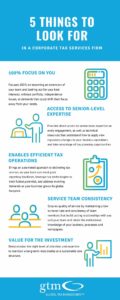Working in the professional tax services industry for more than 15 years — specifically delivering corporate income tax services — has given me the opportunity to observe, and serve, diverse tax department environments. My experience spans the breadth of small start-ups growing quickly – to mid-size private – to large multi-national public companies in a variety of verticals. One thing that stands out is that while each department has their own unique challenges, there are many more similarities than differences.
In this article, I will cover one such similarity, the operational building block of staffing. Staffing is a critical component of any tax department and generally used as a reflection point (or otherwise a barometer) to determine what role the department will ultimately play within the company. Typically, tax departments approach staffing in one of three ways: insourced, out-sourced or co-sourced. I am going to focus this blog on the co-sourcing approach.
There is a Difference Between Co-Sourcing and Loan Staffing
Co-sourcing is an art form, at least as it relates to corporate tax departments. Unfortunately, many people speak of co-sourcing as if it is an exact science. It is often described as a combination of services, tasks, or work performed both by internal staff and external staff to achieve a common goal – a truly collaborative effort. Basically, the internal staff performs the tasks that may require specialized knowledge of the company, controls, and relationships, while the external staff fills in the holes from a technical, risk, or operational perspective.
A co-sourcing engagement is NOT a loan staff engagement. However, many tax departments use these terms interchangeably. Due to this misconception, many companies are not fully optimizing the advantages of the co-sourcing approach, thus leaving significant value on the table.
Here’s the difference:
A loan staff engagement is when a person(s) works in a tax department at the direction of the internal managers of said tax department. Each individual(s) thus reports to the internal tax department personnel and not to their employer (the 3rd party service provider).
A co-sourcing arrangement is a team of people (preparers and reviewers) directed to perform a specific task or function in collaboration with the internal tax department. Third-party resources typically work onsite alongside internal tax department resources. Here are some examples of co-souring:
- Internal tax department consists of only high-level tax personnel
- Internal team performs tax planning, M&A and other value-added services
- 3rd party tax service provider performs all operational tax functions, including the preparation of the tax returns and tax provisions.
- Fully staffed internal tax department
- Internal team is fully operational regarding all aspects of corporate tax
- 3rd party tax service provider can be used to
- perform all compliance and provision functions related to specific business unit(s) within the organization or
- prepare/review all state and local income tax returns (whereas the internal tax department prepares the federal return only)
- Limited staff within internal tax department
- Internal tax team prepares the primary workpapers for tax returns/provisions
- 3rd party tax service provider performs a detailed review of the workpapers and prepares tax returns/provisions, typically using a tax technology solution, such as Thomson Reuters ONESOURCE™, Corptax, Longview, Vertex, etc.
When to Co-Source?
The primary driver of the co-sourcing decision is the current make-up or otherwise strategic vision of the tax department, not, as many think, the size of the corporate tax department. I have seen both large tax departments and small tax departments utilize the co-sourcing approach effectively. Below are a few conditions in the tax department where the co-sourcing option makes sense:
- Tax department concentrates on tax planning and analytics as opposed to operational matters
- Acquisitions of new companies
- Extended hiring freeze
- Lean internal staff
- Internal tax resources focus primarily on management reporting or business unit advisory
More and more, finance and tax leaders want internal tax departments to focus their efforts on minimizing future tax obligations as opposed to preparing tax returns and reporting on tax liabilities of current periods. Putting internal resource time towards planning for the future holds more opportunity than providing the cost-center-type of operations that could easily be co-sourced.
Why Co-Source?
Determining the objectives of an internal tax department is very subjective – and not everyone will agree to what makes the most sense. The trend is moving toward a more collaborative approach with a 3rd party tax operational partner. This is similar to what other business units within the organization have done — co-source with external companies to deliver, produce, or develop a specific part, product or service. Companies are finding new partners to help them manufacture, distribute, or otherwise sell using a faster, smarter, easier approach. Tax departments should be no different. Below I have included some advantages and disadvantages of the co-sourcing approach within the tax department.
Advantages:
- Builds a robust process around the preparation AND the review – leading to lower costs as efficiencies are gained
- Realigns the in-house personnel to add more strategic value
- Provides the ability to easily implement best practices
- Eliminates the need for additional FTE, ultimately reducing costs
- Leverages expertise of a long-term collaborating partner
- Offers flexibility to grow/shrink the engagement
- Increases quality control, timing and data flow
- Gives access to skilled resources that are specialized in the specific area
- Greater knowledge sharing among team members (reduced keyman issues)
Disadvantages:
- Use of in-house resources’ time to provide knowledge transfer
- Relinquishes some ownership of the process
- Incurs short-term costs that may be higher initially than in house process
- Challenges the information gathering process due to coordination with personnel outside of tax
Co-sourcing is certainly not the answer for every tax department, but it has proven fruitful for many. Executed appropriately, significant benefits can be gained, including new opportunities for current personnel, lower long-term costly investments, and more time for tax analytics that can have an impact on business decisions.
Unfortunately, many tax departments use loan staffing as the go-to approach to get by. Focusing only on the loan staff approach (believing that it’s going to garner the same output as the co-sourcing approach) will not provide the value the tax department needs in the short-term or the long-term.
Unlike a loan staff relationship, a co-sourcing relationship provides more than people. Co-sourcing provides the tax department a collaborative partner that consistently brings value, expertise and focus. Many larger organizations are already using multiple tax service providers — utilizing their financial statement auditor as well as an outside firm (or two) to assist with high-end tax planning. The current trend, however, is utilizing an operational partner to help execute the monthly, quarterly and annual reporting obligations while also knowing your people, process, and planning. Think of the value to be gained by teaming with a firm that understands the nuances of your business, the volume and complexity of tax data and your organizational structure. Realizing the added value will build trust and give you the confidence to have that firm in the trenches when time is of the essence.
To sum it up, tax departments need to understand their role in the overall organization and then determine how to deliver. It is the delivery of that role that will influence the approach utilized in building a functional tax department. Co-sourcing is a strong option when operational tax functions, while necessary, aren’t where internal resources are best applied.
Feel free to reach out to me at jdiamond@gtmtax.com with any questions, or visit our Co-Sourced page for more information.



